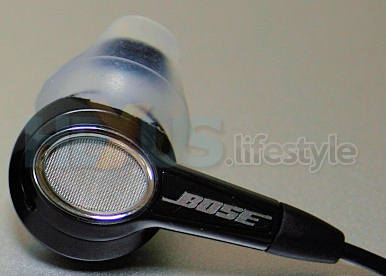In, out, drop 'em all about
Before getting down to the business of comfort, let's first talk about sound quality. With the Bose label and a pretty hefty price-tag of £69, I was expecting this to be good and I wasn't disappointed.
Audio reproduction is excellent - and, as I discovered when listening to a well-spec'd hi-fi system, sounds get better the better the source. There's plenty of detail at the high-end and through the mid-range and enough low-end performance to satisfy the most ardent lover of drum and bass.

Unless you're a bat or a dog – or just have super-human hearing - you, too, are very unlikely to be disappointed with the TriPort's frequency range.
However, I can't actually tell you what that is. Bose, you see, doesn't publish specs or detailed technical info about the TriPorts - and wouldn't even provide any when I asked.
Here's what you get instead of specs at the Bose UK web site:
Dimensions (H x W)
Ear cushion outside dimensions - 3.3 x 2.6cm (One side, medium tip)
Weight
With cables - 18.1g (Two sides, medium tips)
What's In the Box
* 1 pair of in-ear headphones with 1.24m audio cable
* 1 pair each of small, medium and large silicone tips
* Carrying case
Ear cushion outside dimensions - 3.3 x 2.6cm (One side, medium tip)
Weight
With cables - 18.1g (Two sides, medium tips)
What's In the Box
* 1 pair of in-ear headphones with 1.24m audio cable
* 1 pair each of small, medium and large silicone tips
* Carrying case
Click for
larger image
I am fairly sure, however, that the product gets its name from the three holes ('ports') in each earpiece and these are said to produce "greater low-frequency output from a small headphone".
But Bose's own description doesn't make matters any more certain. The only other things it says are,
TriPort®
acoustic headphone structure
BOSE® proprietary technology and innovative design allow the drivers to create deep lows while keeping the headphones small and lightweight. The result is comfortable headphones that deliver the full, balanced low notes of your music.
BOSE® proprietary technology and innovative design allow the drivers to create deep lows while keeping the headphones small and lightweight. The result is comfortable headphones that deliver the full, balanced low notes of your music.
I'm also guessing, but reasonably sure, that the earphones have a higher-than-usual electrical resistance. I've come to that conclusion because they required a good deal more volume to drive than any headphones or earphones that I own.
But I can't say for sure that high resistance - impedance is the technical way of describing it - is the reason because, again, the company simply doesn't provide this information, not even to the knowledge-seeking reviewer. And that's strange, verging on the perverse.
Higher-than-usual impedance won't matter if the earphones are being used with mains-powered kit but can be important when listening to battery-powered players.
A headset with high impedance will consume more power at any particular volume level than one with lower resistance - and that's something to be aware of if the battery life of your personal stereo is critical.
And, realise, too, that it's possible (though far from likely) that you won't be able to get enough volume with the TriPorts if you're listening to an iPod (or other player) that has a severe volume limiter. However, I had no such problem with the two UK-bought players I tried - a 30GByte iPod and a CD personal stereo unit - though neither as far as I am aware is in any way volume-limited.
So what about the all-important question of comfort?
This was what attracted me to the earphones in the first place and it's something that Bose makes much of in its marketing material.
Unfortunately, I couldn't get on with them, Bose brand or not, and irrespective of what size soft tip I used. However, the TriPorts are more comfortable than any other earphones I've tried and were fine in small doses.
Even more important, I suffered a rejection problem - I struggled to keep the things in my ears when on the move.
You might think that me and my ears are to blame but I'm not talking about the earpieces slipping out while doing anything energetic. I don't do jogging and no longer go climbing high peaks on a pogo stick.
The earphones came adrift even while I was doing nothing more energetic than walking about - on the level - in London.
Not surprisingly, the problem was more pronounced with the small ear tip. Trouble is, those were the most comfortable for me to use.
So, what final thoughts are there to share? Find out on page three...










